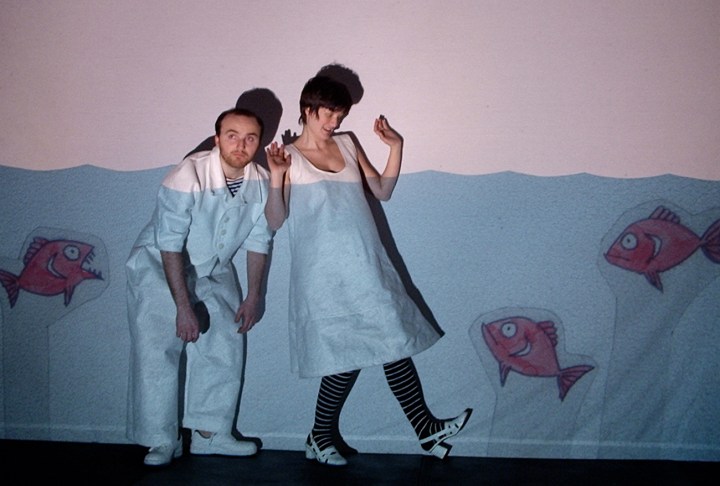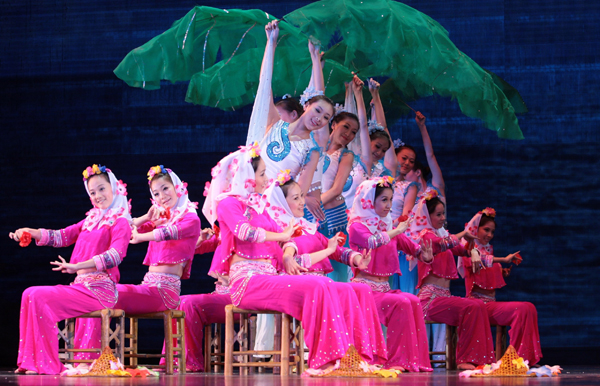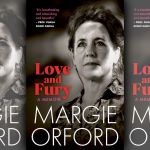Maverick Life, Media, South Africa
Eat, drink, dance, sing and cry at Grahamstown’s 38th arts fest 2012

The Grahamstown National Arts Festival can offer up some surprising contradictions. This year the festival runs from 28 June to 8 July in the middle of Grahamstown’s infamous winter weather. By J BROOKS SPECTOR.
Although it hosts a highly regarded South African university and numerous high-end boarding schools, the city is virtually devoid of any other industry. As a result, for many in the area, the temporary service and support jobs generated by the 10-day festival are the only full-time work they will secure for the entire year – helping explain the severe rate of unemployment in the area.
Despite the region’s hardscrabble poverty, during the festival thousands of South Africans descend upon the city. They buy fistfuls of tickets, shop, eat, definitely drink and often sleep in university residences, the numerous B&B, tents and camp sites and houses rented out by the city’s permanent residents who are only too happy to make some money.
It would be easy to parody the well-to-do, wandering the city in their designer outdoor-wear suitable for arctic expeditions, as they mix with local folk, street people and even the homeless. But for a brief period, the mix in Grahamstown transcends South Africa’s racial divisions in a manner that is still unimaginable in the rest of the country – except in the queue to purchase lottery tickets when the payout is to hit a new record.
Arts festivals generally can serve as a kind of cultural durbar, putting an authoritative stamp on what is acceptable, honoured and officially approved. In essence, they become the arbiter of what is “right”, “good” and “proper”. Alternatively, they become showcases for the “best” or the “new”. More controversially, they become the place where what is on display pushes the envelope of acceptability and challenges limits, poking a sharp stick in the eye of public probity.
The Grahamstown Festival was originally designed as a project of the 1820 Foundation, an organisation dedicated to preserving and advancing the memory of British settlers in Eastern Cape who arrived in 1822, to nourish and protect the English language and culture in Africa, 38 years later this festival has become a very different animal. By contrast, festival managers now take delight in strutting work that aims at the cutting edge and an edginess that puzzles, shocks and even horrifies.
A key element is to showcase country’s rising stars in the arts. As a result, the Standard Bank Young Artist Award winners in drama, dance, music, jazz and visual art, such as performances by 24-year-old opera singer Kelebogile Boikanyo and a new drama by director and now playwright, Princess Zinzi Mhlongo should be popular hits.
Other highlights will include the Fugard Theatre’s world premiere of Athol Fugard’s new play, The Blue Iris, directed by Janice Honeyman, and Yeal Farber’s adaptation and localisation of August Strindberg’s Miss Julie. Then there will also be the controversial David Mamet play, Race, as well as Voices Made Night, adapted from Mia Couto stories and presented by the Cape Town Magnet Theatre. Playwright Craig Higginson, Malcolm Purkey and Neil Coppen will bring Higginson’s latest play, Little Foot, to the stage and Fred Abrahamse and Marcel Meyer will offer a new production of Shakespeare’s A Midsummer Night’s Dream.

Photo: Chinea Fujian Art Troupe Huian Girls.
An exciting aspect of this year’s programme is the launch of a French/South African season that comes via a cooperative agreement between the French embassy and South Africa’s department of arts and culture, including a number of genre-boundary bending works such as Ster City, by French theatre-maker Jean-Paul Delore. The internationally acclaimed Handspring Puppet Company, the people who did Warhorse’s animals, offers I Love You When You’re Breathing and there will also be productions by redoubtable theatrical veterans like Pieter-Dirk Uys, Thembi Mtshali-Jones, Omphie Molusi, Nick Warren and Nicky Rebelo.
Among many other new dance works from South Africa and abroad, the Standard Bank Young Artist for Dance, Bailey Snyman, anchors the festival’s dance programme with a work that confronts the circumstances of being gay in the military, while Vincent Mantsoe, one of this country’s most imaginative choreographers offers Opera for Fools. Of course, there will still be something for the individual who gets nervous when dancers aren’t wearing the traditional tutus. The Cape Town City Ballet offers the old reliable, Giselle, with live music from the KZN Philharmonic Orchestra.
Besides recitals by Kelebogile Boikanyo, this year’s music programme includes more from the KZN Philharmonic in a gala concert conducted by Richard Cock. There are also performances by vibraphonist Frank Mallows and marimba player Magda de Vries, as well as performances of contemporary chamber works composed by Peter Klatzow and David Plylar, and other works that speak to the influences of the African diaspora.

Photo: Mlondolozi Bradley Zondi in Craig Higginson’s Little Foot (Val Adamson)
Meanwhile, Mikhael Subotzky, the 2012 Standard Bank Young Artist for Visual Art shows a new body of work centring on a four-channel film installation. The trend of moving beyond conventional spaces, and inter-linking exhibitions by various artists with each other, and site-specific installations and performances, becomes one of the most exciting aspects of this year’s programme, say organisers.
In slightly less avant-garde terms, Usha Seejarim’s art exhibition, Venus at Home, uses everyday materials to engage with issues of identity. Other exhibitions such as Clare Menck’s, A Hidden Life Exposed, documents her own personal life while My Freedom, My Expression captures 100 years of struggle history in painting and photography.
There will be performance art projects in theatres, museums, galleries, taxi ranks and car parks. The ever-iconoclastic, idiosyncratic Steven Cohen, best known in South Africa for his physically painful, always-provocative performance pieces, joins with Nomsa Dlamini, his 90-year-old co-performer, in The Cradle of Humankind. And Brett Bailey’s Third World Bunfight collective is back to explore the history of human zoos in which people from the non-Western world were exhibited as extraordinary live specimens from the mid-19th century until World War II.
In addition to this list the festival has a regular run of fringe projects from dozens of less-well-known performers as well as free performances such as the visiting China Fujian Art Troupe that will take place over the duration of this festival.
The festival has, for many years had a strong jazz component, this time headlined by the Standard Bank Young Artist for Jazz 2012, Afrika Mkhize. Other performers will include Mango Groove, Ernie Smith, McCoy Mrubata, Morris Goldberg, Andy Narell and Sibongile Khumalo. This is in addition to the 20th anniversary edition of its National Youth Jazz Festival.
The festival came of age in 1990, thrust into the country’s roiling politics and thoroughly shaken out of its comfort zone when Barbara Masekela, newly returned from exile and then the head of the ANC’s cultural policy, spoke on the ANC’s plans for “national culture”. That contentious speech became one of director Lynette Marais’ real “character building” moments as she took much heat and not a few angry and threatening phone calls for hosting such a speech and speaker, even as it presaged the reintegration of South Africa into the world cultural arena. This may sound pretty tame now, but in 1990 it was a brave act.

Photo: Vincent Mantsoe’s Opera for Fools.
Looking back, Marais said, “It was frightening, enlightening and exhilarating.” This was the Lynette Marais of whom SA critic, writer and editor Robert Greig would say: “She transformed what had been a provincial coterie event into a national festival with international status, and did this quietly, modestly and firmly.”
Four years ago, Ismail Mahomed succeeded Marais. He and his artistic advisory committee slowly pushed the festival to an ever-edgier, more controversial event. The festival is now the world’s second largest such gathering after the renowned Edinburgh Festival in Scotland. Mahomed said his ideal festival would be a place where “the best of our arts people wanted to be here, and if performers from southern Africa, and Africa as a whole wanted to come as well.”
To a considerable degree, they have reached this, although the big question hanging over the festival’s success is, as ever, money. Money to support quality programmes, subsidise ticket prices to keep them affordable and support the many free activities available to festival goers is always hard to come by.
I have attended numerous times over the past two-and-a-half decades. From among everything on stage, some programmes continue to stand out years later and seem to represent everything the festival aims to achieve. A couple of years back, I saw young choreographer Dada Masilo’s reimagining of Tchaikovsky’s Swan Lake, drawing deeply on the composer’s own troubled personal life. As the audience filed out, someone next to me said aloud, to no one and everyone, “Some things just make you feel clumsy!” Some years before that, I came to Grahamstown with my daughter, then a music student. As we were driving out of Grahamstown on the way to the airport in Port Elizabeth, we decided to attend one last event – an unheralded performance by a women’s isicatamiya singing group, Tokoza, performing in a small church hall.
The morning was freezing in the way Eastern Cape can be at 8:00. The hall was too big for the group’s staging, there were only a dozen or so members of the audience for this, the final show. But the moment those eight women opened their mouths, we were no longer cold; instead, we were warmed by their grace and humour and their sheer musicality. An experience like that is why one attends and freezes in a B&B where the owner has yet to discover the virtues of heat or hot water. And that last is why we always buy mohair socks and an extra blanket from a craft industry stall when we come to the Grahamstown festival. DM
Read more:
- Home page for the Grahamstown National Arts Festival.
Main photo: Michele Cremaschi and Anna Fascendini in Monolibero 2
Photo:


















 Become an Insider
Become an Insider